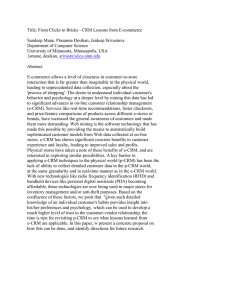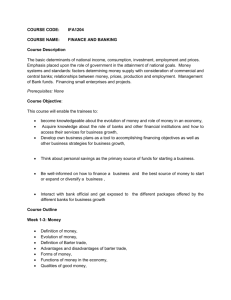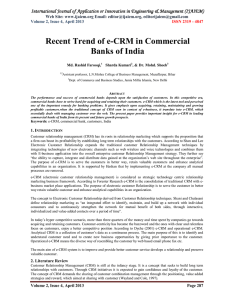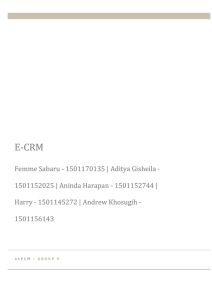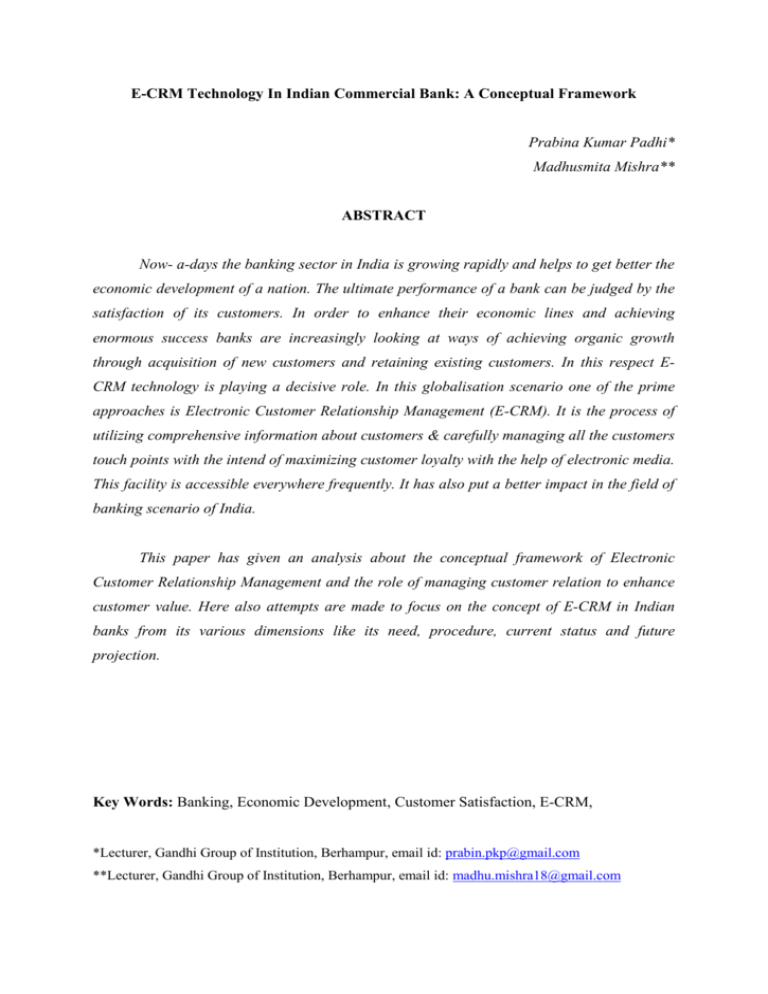
E-CRM Technology In Indian Commercial Bank: A Conceptual Framework
Prabina Kumar Padhi*
Madhusmita Mishra**
ABSTRACT
Now- a-days the banking sector in India is growing rapidly and helps to get better the
economic development of a nation. The ultimate performance of a bank can be judged by the
satisfaction of its customers. In order to enhance their economic lines and achieving
enormous success banks are increasingly looking at ways of achieving organic growth
through acquisition of new customers and retaining existing customers. In this respect ECRM technology is playing a decisive role. In this globalisation scenario one of the prime
approaches is Electronic Customer Relationship Management (E-CRM). It is the process of
utilizing comprehensive information about customers & carefully managing all the customers
touch points with the intend of maximizing customer loyalty with the help of electronic media.
This facility is accessible everywhere frequently. It has also put a better impact in the field of
banking scenario of India.
This paper has given an analysis about the conceptual framework of Electronic
Customer Relationship Management and the role of managing customer relation to enhance
customer value. Here also attempts are made to focus on the concept of E-CRM in Indian
banks from its various dimensions like its need, procedure, current status and future
projection.
Key Words: Banking, Economic Development, Customer Satisfaction, E-CRM,
*Lecturer, Gandhi Group of Institution, Berhampur, email id: prabin.pkp@gmail.com
**Lecturer, Gandhi Group of Institution, Berhampur, email id: madhu.mishra18@gmail.com
I. Introduction
The Electronic Customer Relationship Management (E- CRM) is a well defined series
of functions, skills, processes and technologies which together allow organisations to more
profitably manage customers as tangible assets. It is quiet easy after the adoption of the
internet and availability of electronic channels of communication. In the early 1990s, the
concept of relationship marketing was properly introduced into the services marketing
literature. Financial services institutions, airlines and other service providers found it
profitable to maintain and reward existing customers rather than run after new customers. It
was established that building closer relationships with the customers resulted in better returns
to organizations. Today’s customer not only demands quality products and services but also
looks for value in the transaction process itself. E-CRM is considered as a major corporate
strategy for many organizations. The electronic customer relationship management
encompasses all the CRM functions with the use of the net environment i.e., intranet, extranet
and internet. Electronic CRM concerns all forms of managing relationships with customers
making use of information technology (it). ECRM is enterprises using it to integrate internal
organization resources and external "marketing" strategies to understand and fulfil their
customers’ needs. Comparing with traditional CRM, the integrated information for ECRM
intra organizational collaboration can be more efficient to communicate with customer.
Today, many businesses such as banks, insurance companies, and other service
providers appreciate the significance of Electronic Customer Relationship Management (ECRM) and it’s potential to help them by giving up a way to acquire new customers with
retaining existing ones and make the most of their lifetime value. The banking industry of
India is now running in a dynamic challenge concerning both customer base and
performance. So, they are realising that the magical formulae for attaining success in such a
competitive environment is to focus on maintaining a healthy relationship with customers.
Globalization of business, cut throat competition, customer’s expectation, maintaining loyalty
among customers, to gain more profit, customer retention and strategic customer care have
evolved the recognition of the importance of E- CRM and relationship marketing in the
banking sector.
II. Objectives of Study
E-CRM describes the broad range of technologies used to support a company’s
customer relationship management strategy. It is a very strong approach for creating,
maintaining and expanding customer relationships. Taking this into account followings are
the some of the objectives of the paper:
To acquire proficiency regarding the fundamental concept of E-CRM.
To evaluate essentials of E-CRM in baking sector .
Statement of Problem
In this era of Liberalization, Privatization and Globalization banking sector has become the
backbone of Indian economy. Banking sector being an integral part of Indian financial system
has undergone dramatic changes reflecting the ongoing economic and financial sector
reforms.
III. Review of Literature
Now-a-days companies are focusing on customer relationship management for the
efficient working structure which will result in maximization of profit. Thus through the ECRM technology banks can purpose to go up above minor advantages by developing actual
relationships with their customers. It is due to globalization and technological improvements
have exposed companies to a situation with hard-hitting competition. Following are some
significant literatures which give an overall look regarding the E-CRM technology and its
impact on the Indian banking sector.
Sana Rehman (2012) in her article explains a diverse dimension of this technology.
Her analysis is in relation to the appearance of E-commerce for maintaining successful
customer interaction to create a high impulsive relationship in the context of banking sector.
With this she also highlights the benefit of ECRM from the bank and customer side.
Khare,Arpita and Khare, Anshuman (2008) in their article make available a brief idea
concerning the consequence of E- CRM in the Indian financial sector. They also highlighted
about the practices adopted in the financial organizations in India towards meeting the need
around customer orientation and customer satisfaction. They suggest that CRM can furnish
preeminent results if the enterprises change their processes to make them compatible with the
requirements of the software and the customer and consider CRM as a strategy rather than
only as IT tool. Kennedy (2006) in his article explores idea about the various the marketing
opportunities created by E-CRM for companies in order to boost customer interactions and
relationships to gain the competitive advantage. His paper also gives explanation as regards
to the implementation of E-CRM by managing an on-line channel, data integration issues and
information technology (IT) to solve the various corporate challenges.
Recent Development of Banking Scenario in India
The Indian banking industry is a key driving force of the Indian economy and the most
dominant segment of the financial sector. Banks in India are classified into commercial banks
comprising: 1) Scheduled Commercial Banks (SCBs) and non-scheduled commercial banks;
and 2) co-operative credit institutions that include various co-operative banks. SCBs are
further classified into Public Sector Banks (PSBs), private banks, foreign banks and regional
rural banks (RRBs). The economic reforms initiated by the Government of India roughly
about a decade ago have changed the background of several sectors of the Indian economy.
The Indian banking sector is no exception. This sector is going through key changes as a
result of economic reforms. Undoubtedly, the Indian banking sector today has the identical
sense of enthusiasm and opportunity that is evident in the Indian economy. The fundamental
structural changes in recent years have taught us many lessons. A combination of
developments arising from technological advancements and a liberalized marketplace –
disintermediation, blurring of traditional roles and boundaries, emphasis on shareholder value
creation has led to a transformation of the banking sector.
The Indian banking sector has emerged as one of the strongest drivers of India’s
economic growth. Today Indian Banking is at the crossroads of an invisible revolution.
Financial sector reforms since the early 1990s have resulted in a competitive, healthy and
resilient banking system. Looking back over the past 20 years, there have been massive
changes in the banking sector, which have completely changed the nature of intermediation,
the range of products and services available and the intensity of competition. There have been
many positive developments in the Indian banking sector during the last decade. The sector
has undergone significant developments and investments in the recent past. Most of banks
provide various services such as Mobile banking, SMS Banking, Net banking and ATMs to
their clients. The banking industry has moved gradually from a regulated environment to a
deregulated market economy. The market developments kindled by liberalization and
globalization have resulted in changes in the intermediation role of banks. Changes in policy
and regulation brought about during this period have led to an overall improvement in the
growth, asset quality and profitability of our banks, so that they now compare very favorably
with other banks in the region. The pace of transformation has been more significant in recent
times with technology acting as a catalyst.
IV. E-CRM Technology: An Outline
E-CRM concerned with the creation, development and enhancement of individualized
customer relationships with targeted customers very carefully and customer groups resulting
in maximizing their total customer life time value. The concept of CRM when seen in the
context of e-business or transactions over an electronic medium, it translates in to E-CRM,
which essentially deals with managing customer interactions over the web. It is basically the
electronically managed subset of CRM i.e managing relationships with customers making use
of Information Technology (IT). It is seen to arise from the consolidation of traditional CRM
with the e-business applications marketplace and has created a flurry of activity among
companies. It enables customers to assist themselves by the help of the company’s website.
This facility is available anywhere and anytime. Customer Relationship Management
involves organising activities around the sole customer which can ensure differentiation at
each point of sales by creating a unique customer experience to customer. E-CRM deals with
managing customer interactions over the web which is possible after the adoption of the
Internet and availability of electronic channels of communication. Therefore, E-CRM is
sometimes referred to as web-enabled or web-based CRM and so it has been defined as a web
centric approach to synchronising customer relationships across communication channels,
business functions and audiences. It also emphasises on the practices being adopted in the
organizations in India to enhance their competitiveness through more meaningful interaction
with customers. The business types must address the six Es in E-CRM to optimize the value
of relationship between companies and their customers. They are:
1. Electronic
4. Economics
2. Enterprise
5. Evaluation
3. Empowerment
6. External Information
Types of E-CRM
E-CRM can be divided into three different types:
Operational E-CRM: Operational E-CRM is also known as front-office management.
It enables communications and involves the areas where direct customer contact
occurs.
Analytical E-CRM: Analytical E-CRM is also known as back-office or strategic
which involves understanding the customer activities that occurred in the front office.
Collaborative E-CRM: Collaborative E-CRM is the communication centre of the
coordination network that provides the paths to the customer and supplier. It could
mean a portal, a partner relationship management application or a customer
interaction center.
Importance of E-CRM
E-CRM system enables an organization to provide sales, marketing and service
personnel with better, more complete customer information. By the use of integrated database
to deliver consistent and improved customer responses E-CRM works for the service level
improvements. It also helps the organisation by creating website to market different products
and services. It develops relationship with the customers and facilitates the use of email for
business. E-CRM software helps automate campaigns which includes telemarketing, telesales
lead tracking and response, opportunity management, quotes and order configuration, across
every sector and industry by which the corporate sector can grow rapidly.
The services for the wellbeing of the customers can be summarised as follows:
Customer care support during on and off official hours.
Timely information regarding the interest payments.
Information about the maturity of time deposit.
Facilities of tax payment through debit card.
Online payment facilities.
Issuing credit and debit cum ATM card.
Creating awareness about online and e-banking.
V. Functioning of E-CRM:
In an organisation the adoption of E-CRM technology is very much helpful for its
accelerating growth process. So, E-CRM functioning is necessary in the organisation.
Following are the various steps necessary for the compilation of E- CRM technology.
Step 1: Develop ECRM Vision
Step 2: Define a Strategy Plan
Step 3: Develop a Tactical Plan
Step 4: Market Assessment: In Sourced System and Out Sourced System
Step 5: Train the User
Step 6: Develop Change Programme
Step 7: Check Performance
VI. E-CRM Technologies Used in Organisations
By adopting some of the latest E-CRM techniques, organisations are offering new
products and services to its customers which results in customer satisfaction and acceleration
of the growth process. The use of an E-CRM system enables traditional physical customer
proximity to be substituted by digital proximity. Followings are some of the E-CRM
techniques used in different organisations, especially in banking sector.
1. Use of ATMs
Due to the heavy use of technologies now- a- days ATM services are facilitates in all
most every bank. It helps to make deposits and withdrawal from bank accounts by customers.
The expansion in ATMs helps the banks to enlarge their customer services.
2. Tele banking or Mobile banking
Tele banking is the process by which customer can get knowledge regarding their
bank balance over phone. Similarly they get message for their transaction i.e., deposit and
withdrawal over phone. These facilities help customers to get every benefit over mobile.
3. Internet banking
The banking services provided through internet is known as internet banking. It is
more convenient to use with easy accessibility. Internet banking is used by various banks to
provide information to customers about bank’s products and services through their websites.
It offers many benefits to the banks like reduction of transaction costs, direct marketing and
cross selling, build bank’s brand, etc.
4. E-mail Service
At the present time email facility is considered as one of the cheapest and effective
means of communication. Banks are adopting this technique to inform their customers
regarding the various policies and schemes offered by the bank. Similarly bank can
immediately communicate with the customer over email and can get quick reply also if there
is any urgent notice. Tax payments in the recent years are also possible through the email. So,
it is considered as the quickest method of communication.
5. Computerized Decision Support System
This system helps the bank managers and customers in optimizing investment
decisions. By this technology banks can apply optimization techniques in functional areas
such as, asset–liability management, optimization of investment portfolios and asset
portfolios through linear programming.
6. Customer Smart Cards
These cards include all the relevant in formations, details of previous and repeat
purchases, to make it convenient for the customers to recall all the tracks of purchase trend.
These cards are issued to the key customers. It is also helpful for the banks to keep a record
of each and every behavioural and purchase trends.
7. Computer Networking
Computer networking facility will integrate the front-office applications with backoffice requirements by creating a link between the branches of divisional, regional, zonal and
head office of banks. It provides access to customers’ data base from the executive desk.
8. Data Mining
Data Mining is defined as "the nontrivial extraction of implicit, previously unknown,
and potentially useful information from data”. It is the science of extracting useful
information from large databases. This techniques are helpful to the organizations for
acquiring new customers, fraud detection in real time, providing product segmentation for
better targeting the customers, analysising the customers purchase patterns over time,
exposure of emerging trends to take proactive approach in a highly competitive market
adding a lot more value to existing products and services and launching of new product and
service bundles.
VII. Application of E-CRM in Indian Banks
At present there are five functional categories for online banking sites which offer
customers access to account information, inter-branch funds transfer and utility bill
payments. These are on line brochure centre, interactive bank, e-mails, calculations and cyber
banks. Banks now- a- days are tied up with service providers in telecom and power sectors
like MTNL, BSES, Airtel, Usha Martin and cellular service providers in order to facilitates
their customers to make on line bill payments. In India, new private sector banks like ICICI
Bank, HDFC Bank, Global Trust Bank and UTI Bank, have taken the lead in e-banking.
Among the foreign banks, Citibank, has noticeable presence, while others like Federal Bank,
HSBC Bank, Deutsche Bank and ABN Amro Bank, are moving towards becoming big
players in e-banking. Even by realising the advantages of such services many public sector
banks also adopting these technologies.
Public sector bank like the State Bank of India (SBI) has adopted the net banking
technique. The country’s largest commercial bank launched on-line SBI - an account
browsing facility over the Net for customers in eight select branches including four NRI
branches. Similarly other banks like UTI, HDFC, and ICICI etc. are also adopting E-CRM
technology for their growth with customer satisfaction. UTI bank has tied up with Cosmat
Max, to create a communication network for its customers. The bank has signed a
memorandum of understanding with equitymaster.com for e-brokering activities of the site.
This will enable the bank to leverage its database for e-commerce and other initiatives with
data-warehousing and data-mining, where information of the customer spending habits will
be used to sell other correlated products like credit cards. HDFC Bank has, for the first time
in India made the e-shopping experience secure online and real time with the launch of its
payment gateway. This will allow any Visa/Master credit card holder to make payments for
global services anywhere in the world over the Internet. The bank has tied up with 15 portals
and is in talk with several others to offer secure business to customer e-com. transactions.
The first secure, on-line and real-time e-com. credit card transaction in the country was done
on the Easy.2 shoppe.com shopping mall, enabled by HDFC bank on a Visa card, heralding
the launch of the payment gateway. HDFC Bank also offers a direct debit option whereby its
customer can pay for the goods or services by a secure password enabled transfer of funds
from their account to the merchant account.
IX. Conclusion
E-CRM as a contemporary fast growing technology solves various corporate
problems and helps in the development of these sectors. At the present era there is a
knowledge gap exist between the formulation and implementation of E-CRM which can be
eliminated by the proper guidance over this concept. Successful implementation of E-CRM is
brought numerous competitive advantages like reducing response time, modernism in
banking services, get better response to customer activity, preparation of up to date
technology and improve integrated customer profitability. The banks must adopt E-CRM and
build their brand image in assuring customers about the safety of their money and security of
transaction on the internet.
References:
1. Khare,,Arpita and Khare, Anshuman (Canada), (2008), “Managing Customer
Relationships Using CRM Technology In India’sFinancial Sector”, Banks and Bank
Systems, , Volume 3, Issue , pp. 14-21.
2. Kotler , Philip (2008), “ Principles of marketing”, Upper Saddle River, N.J.Pearson
Prentice Hall
3. Mittal, R.K. and Kumra, Rajeev (2001), “E-CRM in Indian banks an overview”,
Delhi Business Review, Vol. 2, No. 1, January – June.
4. Nor Azila and Mohd Noor (2011) Electronic Customer Relationship Management
Performance: Its Impact on Loyalty From Customers ‘Perspectives by International
Journal of e-Education, e-Business, e-Management and e-Learning, Vol. 1, No. 1,
5. Rehman , Sana (2012), “Influence of E-commerce and its emerging innovations in
banks” IJMT, Volume 2, Issue 8 ISSN: 2249-1058, pp. 289-303.
6. Sarangapani, A (2008), Customer Relationship Management in Banking Sector,
Journal of Professional Banker, pp. 39-47.
7. Saymote, Abhijeet and Natu, Namita N., (2011), “Study of CRM in Indian Banking
Industry”, ISRJ, Vol - I, ISSUE - June 2011, ISSN No: 2230-7850.
8. Sudalaimuthu, Dr., S,(2008), “E-CRM New Technology Innovation in the Banking
Industry”, e-track business of future, quarterly journal, Vol VI(1)
9. www.icici.in
*****

